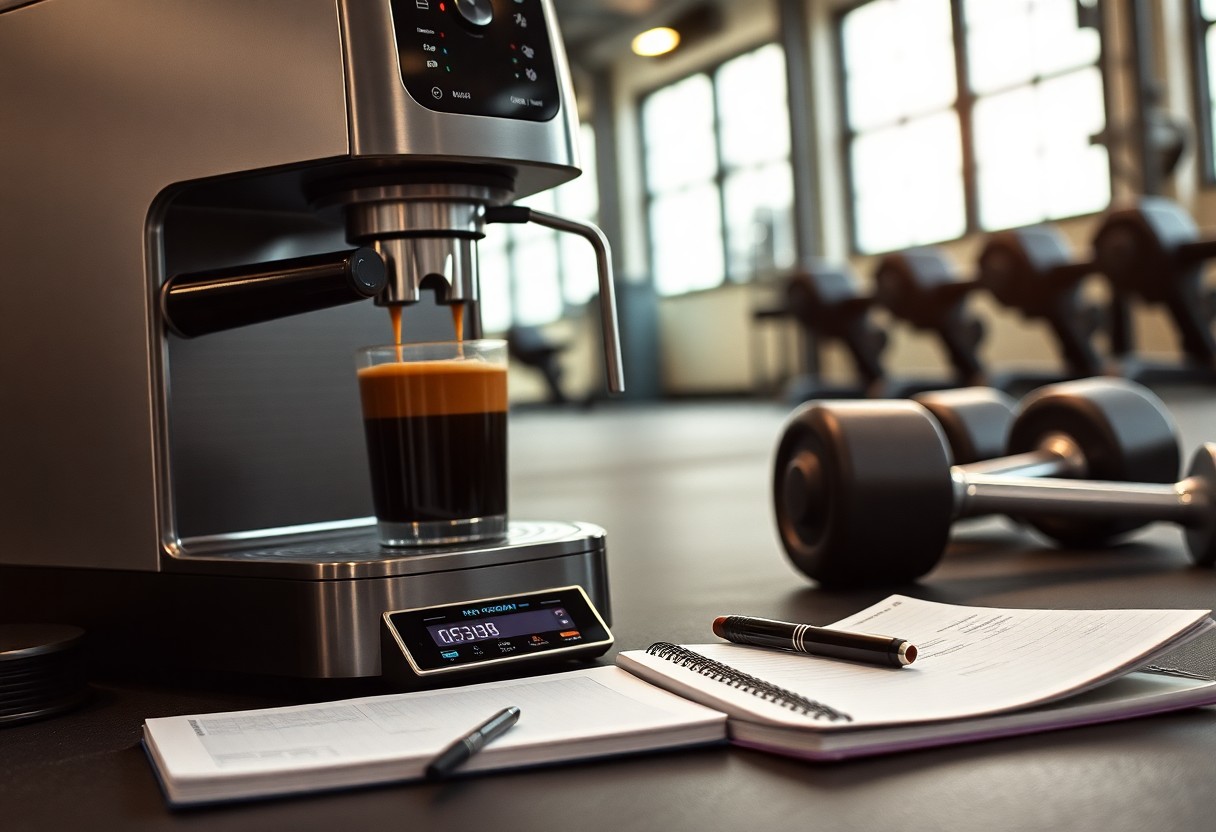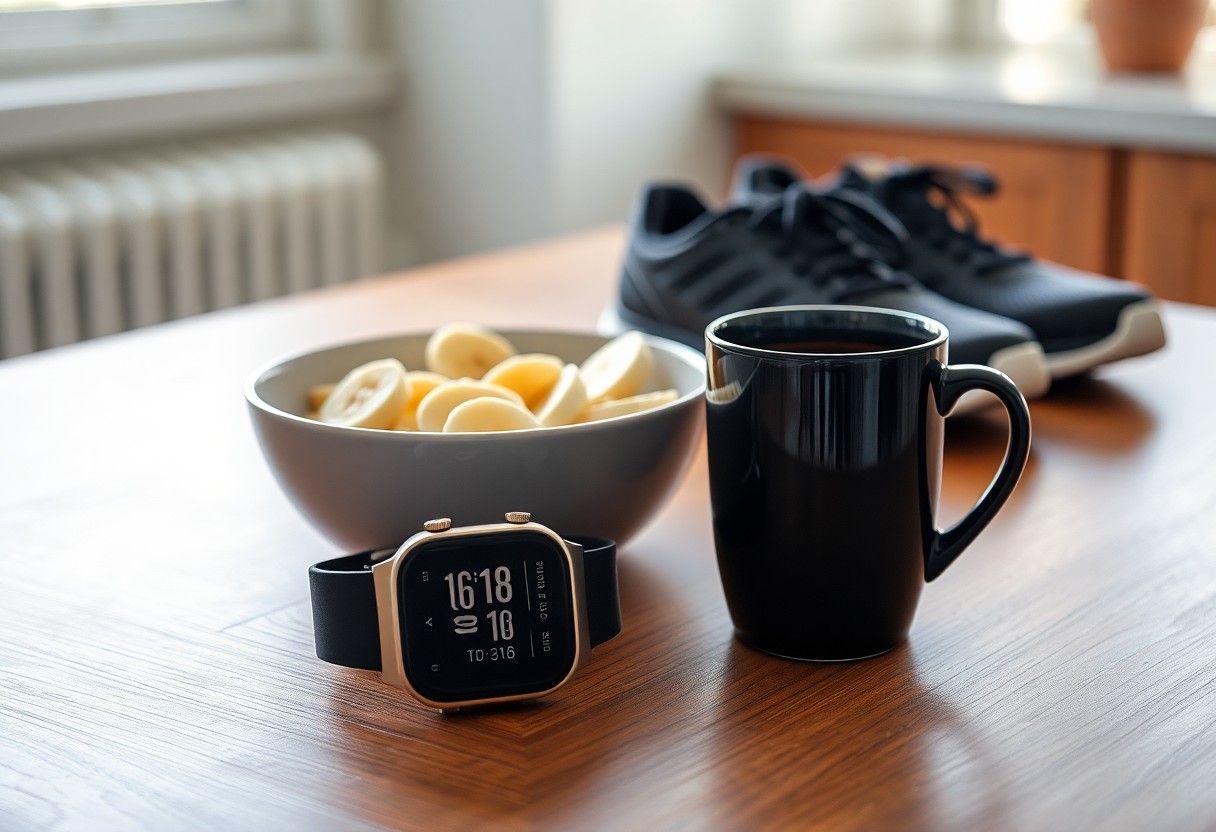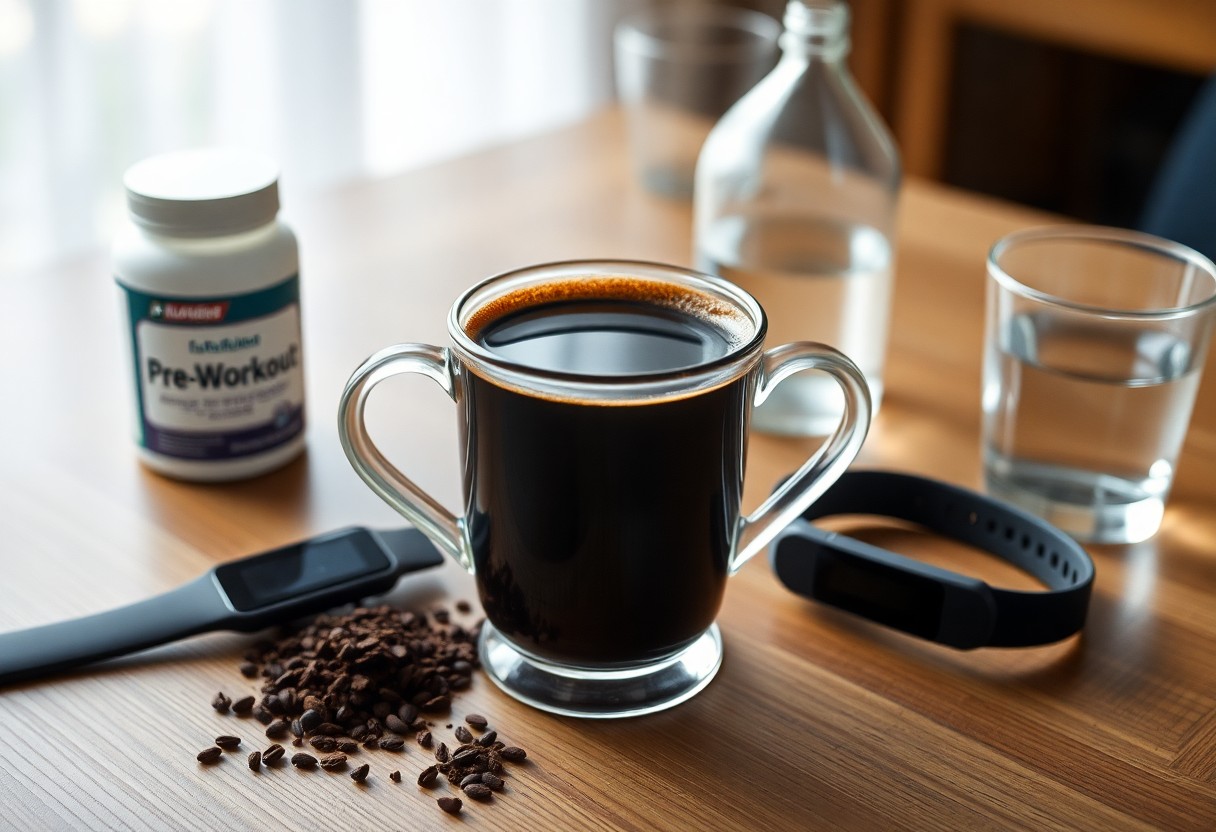Most fitness enthusiasts look for an effective energy boost before exercising, and coffee can offer just that. However, consuming too much caffeine can lead to unwanted jitters that may hinder your workout instead of helping it. In this guide, you’ll discover how to harness the power of coffee safely, optimizing your performance without the negative side effects. With just a few simple guidelines, you can make coffee a part of your pre-workout routine to enhance focus and energy levels, ensuring a more productive session every time.
Key Takeaways:
- Consume coffee about 30-60 minutes before your workout to allow caffeine levels to peak.
- Limit your intake to one to two cups to avoid excessive caffeine, which can lead to jitters and anxiety.
- Pair your coffee with a small carbohydrate snack to enhance energy levels and mitigate potential side effects.

The Science of Caffeine and Performance Enhancement
Caffeine’s role as a performance enhancer is backed by extensive research, showing it can improve both physical and cognitive aspects of exercise. When you consume caffeine, it increases the release of adrenaline, which prepares your body for intense physical exertion. A systematic review indicated that doses of 3-6 mg per kilogram of body weight can enhance physical performance, particularly in endurance sports, by allowing you to exert more effort for longer periods. This makes it a popular choice for athletes looking to maximize their workouts without the associated jitters that high doses can sometimes bring.
How Caffeine Affects Physical Endurance
Incorporating caffeine into your pre-workout routine can significantly improve your physical endurance. Studies have shown that caffeine consumption before exercise can increase your time to exhaustion, meaning you can work out longer before feeling fatigued. This effect is primarily due to enhanced mobilization of fatty acids and increased oxidation during exercise, allowing your body to utilize fat as fuel more effectively. As a result, you can push through tough workouts and achieve new personal bests.
The Role of Neurotransmitters in Exercise Motivation
Caffeine also impacts various neurotransmitters that play a vital role in exercise motivation. By influencing dopamine and serotonin levels, caffeine creates a sense of alertness and well-being, making you feel more motivated to engage in physical activity. Studies point out that increased dopamine can elevate your mood and decrease the perception of effort, helping you push through even the most challenging workouts. This mental boost can be just as necessary as the physical benefits, ensuring your drive to work out is as strong as your physical ability.
The effect of neurotransmitters like dopamine when consuming caffeine extends beyond just motivation; it fundamentally alters your perception of fatigue during exercise. For instance, with elevated dopamine levels, you may find yourself less aware of discomfort or fatigue, enabling you to sustain higher levels of exertion for longer. This psychological enhancement directly correlates with improved performance, allowing you to complete more reps, run further, or push harder throughout your workout—necessaryly maximizing the efficiency of your fitness regime.
Finding Your Perfect Dose
Pinpointing the right amount of coffee to enhance your performance without leading to jitters involves a bit of experimentation. Start with a small serving—about one cup—and gradually increase the amount, paying close attention to how your body reacts. Most studies suggest that a dose of 3-6 mg of caffeine per kilogram of body weight can yield optimal results, so you can calculate your specific needs based on your weight. This personalized approach empowers you to harness coffee’s strengths while minimizing any adverse effects.
Determining Personal Tolerance Levels
Your body’s sensitivity to caffeine can vary significantly from others. Some people may experience noticeable effects from just one cup, while others can tolerate several cups without side effects. To identify your tolerance, keep a record of your coffee consumption and how you feel during workouts. This way, you’ll find your sweet spot that enhances your performance without the unwanted jittery feelings.
Timing Your Coffee Intake for Maximum Effect
Taking your coffee at the right time can maximize the benefits you reap from caffeine. Ideally, consuming coffee about 30-60 minutes before your workout allows caffeine levels to peak in your bloodstream, enhancing your endurance and focus. For long sessions, consider sipping on an additional cup midway through your workout for sustained energy. Experiment with different timings to determine what works best for you and aligns with your individual workout schedule.
Brewing Techniques That Minimize Jitters
Choosing the right brewing method can significantly impact your coffee’s caffeine content and your workout experience. Opt for techniques that lower acidity and intensity by reducing the extraction time of caffeine. For instance, brewing methods like cold brew or using a French press allow for a smoother profile and less perceived jitters, as they extract lower levels of caffeine while preserving flavor. Similarly, using coarsely ground beans and filtering your coffee well can also help mitigate the jitters often associated with higher caffeine levels.
The Best Coffee Beans for Pre-Workout
Select coffee beans that are low in acidity and rich in flavor to enhance your pre-workout experience. Single-origin beans, particularly those sourced from Brazil or Colombia, are often favored as they provide a smoother taste while still packing a caffeine punch. You might also consider blends that include Arabica beans to enjoy a balanced flavor profile with minimal side effects, keeping jitters at bay.
Brewing Methods: From Espresso to Cold Brew
Different brewing methods yield distinct caffeine levels and flavor profiles. For example, espresso packs a concentrated caffeine dose in a small serving, while cold brew is known for its smoothness and reduced acidity due to a longer steeping process in cold water. Utilizing methods like Aeropress or pour-over can strike the perfect balance, allowing you to control extraction rates and customize your coffee’s intensity. Experimenting with brew times and techniques will help you find what best suits your body—keeping jitters in check while still reaping the benefits of that pre-workout energy boost.
Exploring various methods offers you an opportunity to tailor your coffee experience. Cold brew, for instance, tends to contain about 50% less acidity than traditional hot brews, which can significantly reduce digestive discomfort and jitters. On the other hand, espresso may provide a quick caffeine surge but comes with a sharp flavor that isn’t for everyone. By adjusting brew times, grind sizes, and water temperatures, you create a coffee that aligns with your taste and energy needs, making workouts more enjoyable and effective.
Complementing Coffee with Nutritional Strategies
Utilizing coffee as a pre-workout boost is most effective when combined with smart nutritional strategies. Fueling your body with the right nutrients not only enhances the energizing effects of coffee but also helps sustain your energy throughout the workout. Focus on incorporating carbohydrates and protein into your routine for optimal performance. Pairing your coffee with a balanced snack can maximize endurance and recovery while preventing that dreaded crash from caffeine alone.
Pairing Coffee with Pre-Workout Snacks
Team up your coffee with a pre-workout snack rich in complex carbohydrates and a moderate amount of protein. Options like a banana with almond butter or a slice of whole-grain toast topped with avocado can provide the necessary energy boost while complementing the caffeine’s stimulating effects. This combo ensures your body has the fuel it needs for intense workouts without experiencing sudden spikes in sugar levels.
Hydration: Balancing Caffeine with Fluid Intake
Balancing your caffeine intake with proper hydration is crucial for maximizing your workout performance. Caffeine can act as a diuretic, increasing urine production, so drinking ample water throughout the day is necessary. Aim for at least 20 ounces of water before your workout to stay hydrated and offset any dehydrating effects from coffee. Increase your fluid intake based on exercise duration and intensity to keep energy levels high.
Inadequate hydration can lead to fatigue and diminished performance, especially when caffeine is involved. Consuming coffee can lead to mild dehydration, so offsetting it with sufficient water intake is vital. Keep a water bottle handy and sip consistently throughout your workout. Aim to drink around 8-10 ounces of water every 15-20 minutes during intense exercise sessions. This will help maintain energy levels and enhance your overall endurance and focus during workouts.

Mindset: Setting Yourself Up for Success
Your mindset plays a pivotal role in how effectively you utilize coffee as a pre-workout stimulant. Start by visualizing your workout goals and affirming your commitment to achieving them. Engaging in a positive mental dialogue helps form a strong foundation for your exercise session. Adopting a success-oriented mindset not only increases motivation but also enhances focus, allowing you to push through potential fatigue and embrace a productive training environment.
Building a Pre-Workout Ritual Around Coffee
Creating a consistent pre-workout ritual centered around coffee can amplify your results. Consider brewing a fresh cup while you prepare your workout gear and mentally map out your training routine. This combination of physical preparation and caffeine consumption serves to sharpen your focus and generates excitement, mentally signaling to your body that it’s time to perform.
Mental Techniques to Harness Caffeine Effectively
To maximize caffeine’s benefits, employ mental techniques such as visualization and mindful breathing. Envision yourself completing challenging sets effortlessly or achieving personal records. Pair these images with deep breathing to maintain a calm, energized state as caffeine stirs excitement within your body. This blend of visualization with regulated breathing can transform the jitters into powerful motivation.
Research suggests that mental imagery can significantly improve performance by priming your brain for the physical exertion ahead. Consider using a structured visualization technique where you picture each part of your workout in detail, from starting conditions to the end goal. When paired with the energizing effects of caffeine, these techniques can help you remain focused and driven, channeling the caffeine buzz into productive energy rather than anxiety. Over time, this practice can enhance not only your workouts but also your overall mindset towards fitness.
To Wrap Up
Considering all points, using coffee as a pre-workout can enhance your performance without the unwanted jitters if you pay attention to timing, quantity, and personal tolerance. Start with a moderate amount, ideally 30-60 minutes before your workout, and opt for brewed coffee or espresso over highly caffeinated energy drinks. Additionally, pairing your coffee with a small snack can stabilize your energy levels. By experimenting with these strategies, you’ll be better equipped to enjoy the benefits of caffeine while minimizing side effects, ultimately leading to a more effective workout routine.
FAQ
Q: How can I properly prepare coffee to use as a pre-workout without experiencing jitters?
A: To minimize the risk of jitters while still reaping the benefits of coffee as a pre-workout, consider brewing your coffee in a way that achieves a moderate caffeine level. Opt for a light roast, as it typically contains slightly less caffeine than dark roasts. Additionally, try consuming about half a cup of coffee 30 to 45 minutes before your workout. This timing allows your body to absorb the caffeine efficiently without overwhelming your system.
Q: What are the best coffee types or blends to use as a pre-workout drink?
A: Light roast coffees or cold brew options are often recommended because they can provide an energy boost without the higher acidity and caffeine levels found in darker roasts. Single-origin coffees with a lower caffeine content can also be beneficial. If you’re sensitive to caffeine, consider selecting brands that specifically advertise lower caffeine blends.
Q: Can I mix other ingredients with coffee to enhance its pre-workout effects and minimize jitters?
A: Absolutely! Combining coffee with ingredients like almond milk, a pinch of salt, or even some vanilla extract can not only enhance the flavor but also help to mitigate the jitters. Adding protein powder or a scoop of nut butter can provide additional energy and sustain your blood sugar levels, which may reduce anxiety triggered by caffeine.
Q: How much caffeine is generally considered safe for pre-workout use?
A: For most individuals, a dose of 3-6 mg of caffeine per kilogram of body weight is considered effective for enhancing performance without causing significant side effects. This means that an average person weighing around 70 kg (154 lbs) can aim for around 210-420 mg of caffeine. Start with a lower amount, especially if you are new to using coffee pre-workout, and assess how your body reacts before increasing the dosage.
Q: What alternative options can I consider if coffee still causes jitters for me?
A: If you find that coffee continues to give you jitters or anxiety, consider alternatives like green tea, which contains less caffeine and includes L-theanine—a compound known for its calming effects. Electrolyte drinks or additional recovery powders can also provide energy without the jittery feeling often associated with high caffeine intake. Experimenting with these alternatives can help you find what works best for your body.
